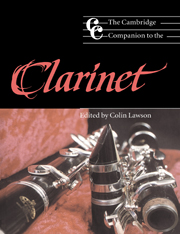Book contents
- Frontmatter
- 1 Single reeds before 1750
- 2 The development of the clarinet
- 3 The clarinet family
- 4 The development of the clarinet repertoire
- 5 Players and composers
- 6 The mechanics of playing the clarinet
- 7 Teaching the clarinet
- 8 Playing historical clarinets
- 9 The professional clarinettist
- 10 The contemporary clarinet
- 11 The clarinet in jazz
- 12 The clarinet on record
- Notes
- Appendices
- Select bibliography
- Index
2 - The development of the clarinet
Published online by Cambridge University Press: 28 September 2011
- Frontmatter
- 1 Single reeds before 1750
- 2 The development of the clarinet
- 3 The clarinet family
- 4 The development of the clarinet repertoire
- 5 Players and composers
- 6 The mechanics of playing the clarinet
- 7 Teaching the clarinet
- 8 Playing historical clarinets
- 9 The professional clarinettist
- 10 The contemporary clarinet
- 11 The clarinet in jazz
- 12 The clarinet on record
- Notes
- Appendices
- Select bibliography
- Index
Summary
Introduction
The clarinet may be defined as a woodwind instrument with a predominantly cylindrical bore and a single reed that overblows at the twelfth. The term ‘woodwind’ does not preclude the instrument being made of a material other than wood; indeed, at least one of the few surviving very early clarinets is made of ivory. As regards overblowing at the twelfth, the assumption that one can use identical fingering in the chalumeau and clarinet registers has rather less validity on earlier clarinets than modern ones. With these reservations, the clarinet can be traced back to the beginning of the eighteenth century, when it is generally believed to have been invented by Johann Christoph Denner in Nuremberg, as outlined in Chapter 1. Instruction tutors for the clarinet go back more than 200 years, and almost from the beginning the tutor has normally opened with a brief history of the instrument. Originally this was not regarded as having much importance, nor are these brief histories very reliable. My presumption in this chapter is that it will be read by people interested in how the clarinet they know today evolved, or in playing or listening to earlier clarinets, and I will bypass aspects of the history of the instrument that seem to me less interesting from this point of view. This is a major restriction, because many of the fascinating and ingenious inventions that have been applied to the clarinet seem to have had no significant effect either at the time, or subsequently.
- Type
- Chapter
- Information
- The Cambridge Companion to the Clarinet , pp. 16 - 32Publisher: Cambridge University PressPrint publication year: 1995
- 1
- Cited by



